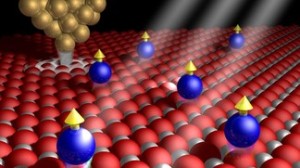May 21 2014
An EPFL-led research collaboration has shown for the first time the maximum theoretical limit of energy needed to control the magnetization of a single atom. The fundamental work can have great implications for the future of magnetic research and technology.
 Cobalt atoms (blue) interacting with the MgO surface, microscope tip (gold) and X-rays © 2014 EPFL
Cobalt atoms (blue) interacting with the MgO surface, microscope tip (gold) and X-rays © 2014 EPFL
Magnetic devices like hard drives, magnetic random access memories (MRAMs), molecular magnets, and quantum computers depend on the manipulation of magnetic properties. In an atom, magnetism arises from the spin and orbital momentum of its electrons. ‘Magnetic anisotropy’ describes how an atom’s magnetic properties depend on the orientation of the electrons’ orbits relative to the structure of a material. It also provides directionality and stability to magnetization. Publishing in Science, researchers led by EPFL combine various experimental and computational methods to measure for the first time the energy needed to change the magnetic anisotropy of a single Cobalt atom. Their methodology and findings can impact a range of fields from fundamental studies of single atom and single molecule magnetism to the design of spintronic device architectures.
Magnetism is used widely in technologies from hard drives to magnetic resonance, and even in quantum computer designs. In theory, every atom or molecule has the potential to be magnetic, since this depends on the movement of its electrons. Electrons move in two ways: Spin, which can loosely be thought as spinning around themselves, and orbit, which refers to an electron’s movement around the nucleus of its atom. The spin and orbital motion gives rise to the magnetization, similar to an electric current circulating in a coil and producing a magnetic field. The spinning direction of the electrons therefore defines the direction of the magnetization in a material.
The magnetic properties of a material have a certain ‘preference’ or ‘stubbornness’ towards a specific direction. This phenomenon is referred to as ‘magnetic anisotropy’, and is described as the “directional dependence” of a material’s magnetism. Changing this ‘preference’ requires a certain amount of energy. The total energy corresponding to a material’s magnetic anisotropy is a fundamental constraint to the downscaling of magnetic devices like MRAMs, computer hard drives and even quantum computers, which use different electron spin states as distinct information units, or ‘qubits’.
The team of Harald Brune at EPFL, working with scientists at the ETH Zurich, Paul Scherrer Institute, and IBM Almaden Research Center, have developed a method to determine the maximum possible magnetic anisotropy for a single Cobalt atom. Cobalt, which is classed as a ‘transition metal’, is widely used in the fabrication of permanent magnets as well as in magnetic recording materials for data storage applications.
The researchers used a technique called inelastic electron tunneling spectroscopy to probe the quantum spin states of a single cobalt atom bound to a magnesium oxide (MgO) layer. The technique uses an atom-sized scanning tip that allows the passage (or ‘tunneling’) of electrons to the bound cobalt atom. When electrons tunneled through, they transferred energy the cobalt atom, inducing changes in its spin properties.
The experiments showed the maximum magnetic anisotropy energy of a single atom (~60 millielectron volts) and the longest spin lifetime for a single transition metal atom. This large anisotropy leads to a remarkable magnetic moment, which has been determined with synchrotron-based measurements at the X-Treme beamline at the Swiss Light Source. Though fundamental, these findings open the way for a better understanding of magnetic anisotropy and present a single-atom model system that can be conceivably used as a future ‘qubit’.
“Quantum computing uses quantum states of matter, and magnetic properties are such a quantum state”, says Harald Brune. “They have a life-time, and you can use the individual suface-adsorbed atoms to make qubits. Our system is a model for such a state. It allows us to optimize the quantum properties, and it is easier than previous ones, because we know exactly where the cobalt atom is in relation to the MgO layer.”
This work represents a collaboration between EPFL’s Laboratory of Nanostructures at Surfaces (LNS), IBM’s Almaden Research Center, ETH Zurich’s Department of Materials, Paul Scherrer Institute’s Swiss Light Source, and Georgetown University’s Department of Physics.
Reference
Rau IG, Baumann S, Rusponi S, Donati F, Stepanow S, Gragnaniello L, Dreiser J, Piamonteze C, Nolting F, Gangopadhyay S, Albertini OR, Macfarlane RM, Lutz CP, Jones B, Gambardella P, Heinrich AJ, Harald Brune. Reaching the magnetic anisotropy limit of a 3d metal atom. Science 08 March 2014 DOI:10.1126/science.1252841
Author: Nik Papageorgiou
Source: Centre de l'énergie